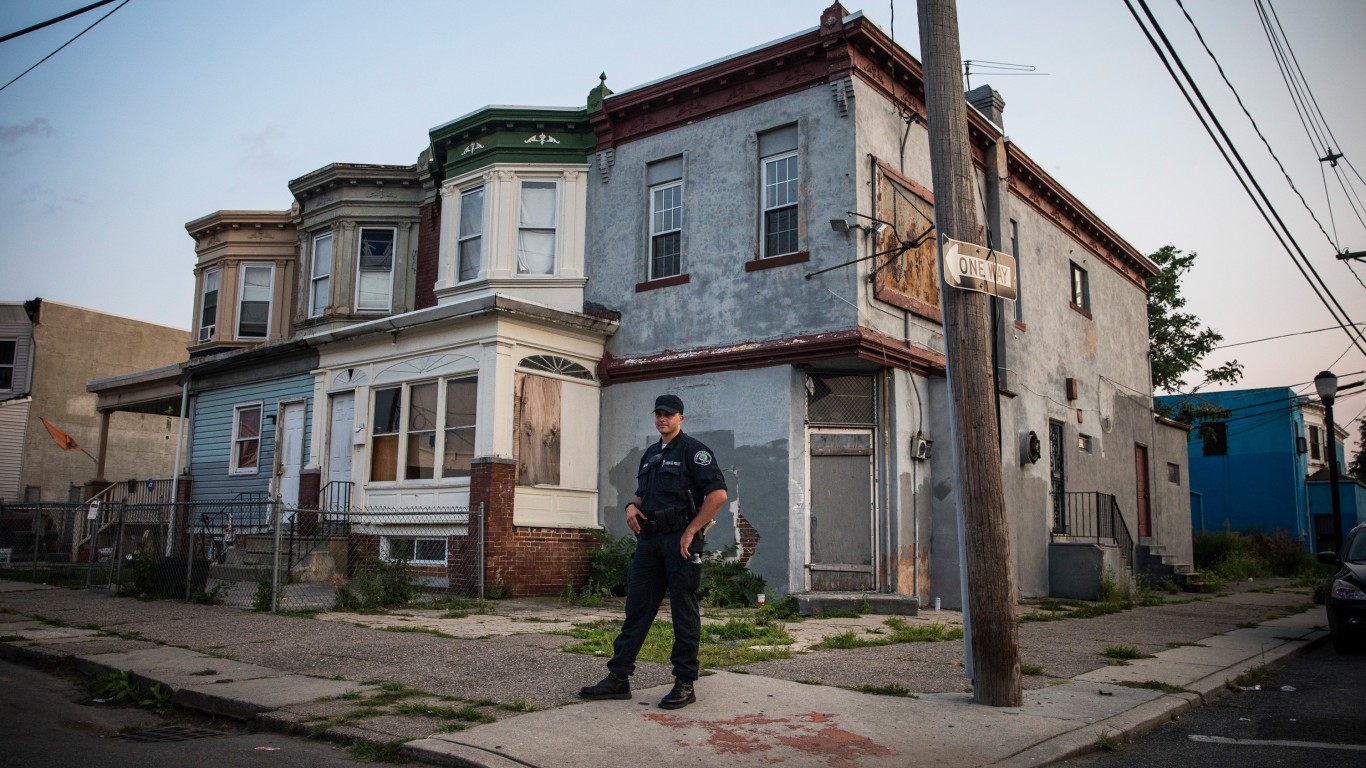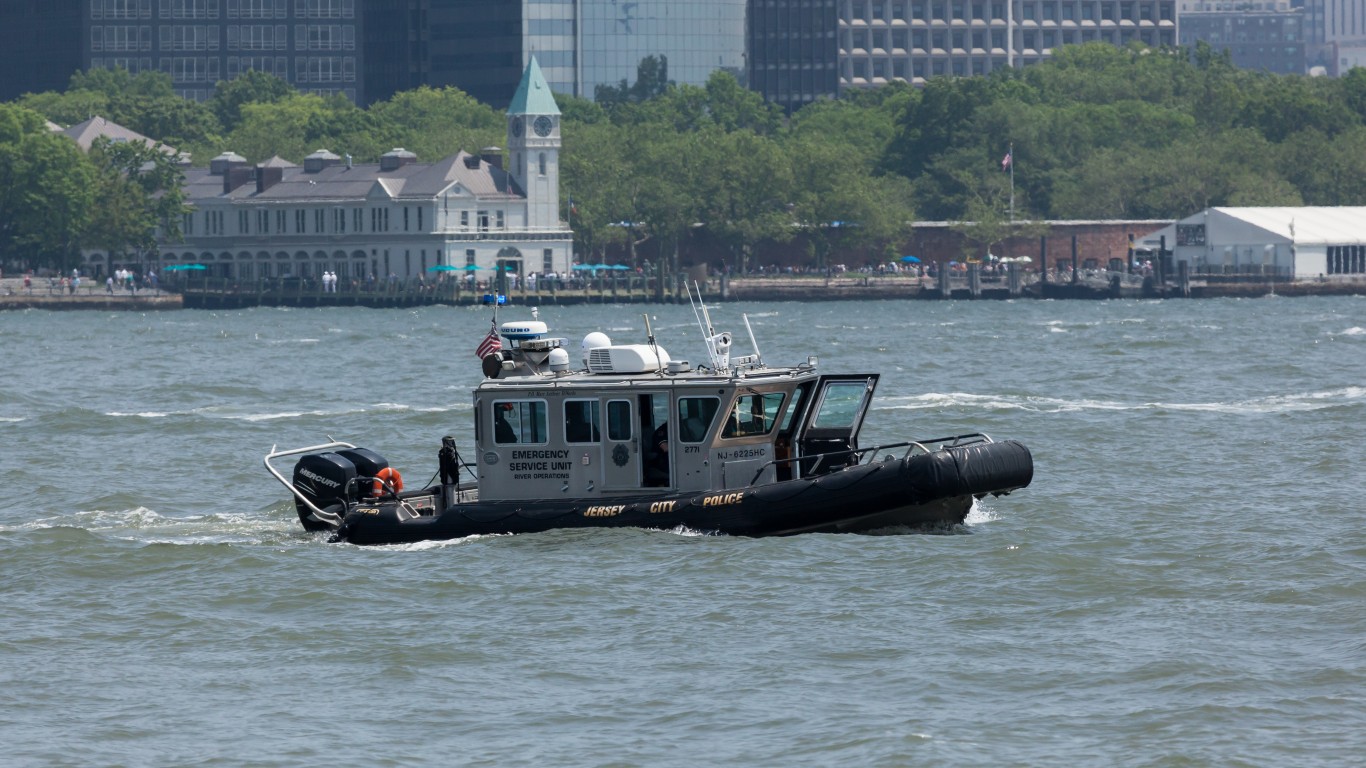Special Report
How the Crime Rate in New Jersey Compares to the Rest of the Country

Published:

Violent crime has been trending downward in the United States for decades. According to the FBI, the U.S. violent crime rate — a population-adjusted measure that includes incidents of robbery, homicide, and aggravated assault — fell by nearly 90% between the mid-1990s and mid-2010s. Though a historic surge in homicides helped drive the violent crime rate up in 2020, the U.S. remains far safer than it was at any point in the 1990s.
Over the 26 year period of comprehensive FBI data, beginning in 1995 and going through 2020, the number of violent crimes reported annually in the U.S. ranged from about 1.8 million, down to less than 1.2 million. Over the same period, the violent crime rate peaked at 684 incidents for every 100,000 people in 1995, and hit a multi-decade low of 362 per 100,000 in 2014.
The FBI also tracks violent crime rates at the state level, and New Jersey has been safer than the U.S. as a whole for over two and a half decades. Every year between 1995 and 2020, the violent crime rate in New Jersey has been lower than the national rate, often by a wide margin.
Like the U.S. as a whole, the violent crime rate in New Jersey has improved substantially since the 1990s. As of 2020, New Jersey’s violent crime rate was 67% lower than it was in 1995 — and in each of the last four years, New Jersey has ranked among the 10 safest states in the country.
While some factors that led to the reduction of criminal violence remain unknown, experts have identified several likely underlying causes. According to a report from the Brennan Center for Justice, a non-profit policy institute, these include an aging population, declining alcohol use, increased policing and incarceration, and several economic conditions related to inflation, unemployment, and consumer confidence.
While homicide is the most serious violent offense in the FBI’s hierarchy of violent offenses, it is also the least common. In the last 26 years, homicides have never accounted for more than 2% of all violent crimes reported in New Jersey. In contrast, aggravated assault has accounted for at least 46% of all violent offenses reported in New Jersey every year.



























| Year | Violent crimes per 100,000 people in New Jersey | Violent crimes per 100,000 people in the U.S. | Total violent crimes in New Jersey | Total violent crimes in U.S. |
|---|---|---|---|---|
| 2020 | 195.4 | 398.5 | 17,353 | 1,313,105 |
| 2019 | 206.7 | 380.8 | 18,382 | 1,250,393 |
| 2018 | 208.6 | 383.4 | 18,536 | 1,252,399 |
| 2017 | 231.8 | 394.9 | 20,604 | 1,283,875 |
| 2016 | 243.5 | 397.5 | 21,861 | 1,285,606 |
| 2015 | 256.0 | 373.7 | 22,879 | 1,199,310 |
| 2014 | 260.9 | 361.6 | 23,319 | 1,153,022 |
| 2013 | 288.9 | 369.1 | 25,748 | 1,168,298 |
| 2012 | 290.1 | 387.8 | 25,727 | 1,217,057 |
| 2011 | 307.9 | 387.1 | 27,203 | 1,206,031 |
| 2010 | 307.5 | 404.5 | 27,055 | 1,251,248 |
| 2009 | 311.4 | 431.9 | 27,113 | 1,325,896 |
| 2008 | 326.5 | 458.6 | 28,351 | 1,394,461 |
| 2007 | 328.6 | 471.8 | 28,544 | 1,422,970 |
| 2006 | 350.2 | 479.3 | 30,550 | 1,435,123 |
| 2005 | 355.3 | 469.0 | 30,919 | 1,390,745 |
| 2004 | 356.3 | 463.2 | 30,943 | 1,360,088 |
| 2003 | 364.3 | 475.8 | 31,488 | 1,383,676 |
| 2002 | 376.1 | 494.4 | 32,252 | 1,423,677 |
| 2001 | 388.8 | 504.5 | 33,094 | 1,439,480 |
| 2000 | 383.8 | 506.5 | 32,298 | 1,425,486 |
| 1999 | 411.9 | 523.0 | 33,540 | 1,426,044 |
| 1998 | 440.2 | 567.6 | 35,720 | 1,533,887 |
| 1997 | 492.6 | 611.0 | 39,673 | 1,636,099 |
| 1996 | 531.5 | 636.6 | 42,459 | 1,688,540 |
| 1995 | 599.8 | 684.5 | 47,652 | 1,798,792 |
Retirement can be daunting, but it doesn’t need to be.
Imagine having an expert in your corner to help you with your financial goals. Someone to help you determine if you’re ahead, behind, or right on track. With SmartAsset, that’s not just a dream—it’s reality. This free tool connects you with pre-screened financial advisors who work in your best interests. It’s quick, it’s easy, so take the leap today and start planning smarter!
Don’t waste another minute; get started right here and help your retirement dreams become a retirement reality.
Thank you for reading! Have some feedback for us?
Contact the 24/7 Wall St. editorial team.